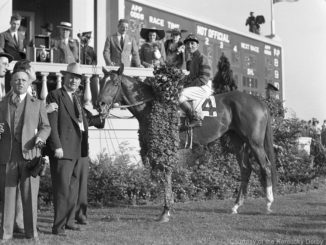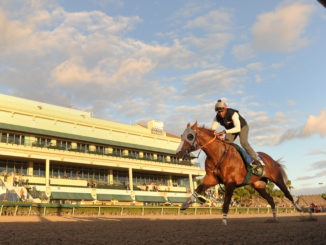
It feels like an alternate universe to say that the Triple Crown starts with the 1 1/8-mile Belmont S. (G1) on Saturday, instead of its concluding the series as a 1 1/2-mile “Test of the Champion.”
Such is the new world of dealing with the ramifications of COVID-19. Presumably the 2020 Belmont will be a one-off, an asterisk that will require an explanation for future generations.
Along with changing guise to a one-turn event at Belmont Park, the oldest of the U.S. classics has become a qualifying race on the Road to the Kentucky Derby, worth points on a 150-60-30-15 scale.
But at least the presence of hot favorite Tiz the Law lends some substance after a few major defections. Although an upset could undermine that idea, the point stands that he’s an elite performer who brings a resume worthy of a classic winner. And if an improving rival can pull a stunner, the upsetter would gain stature in a way he couldn’t without Tiz the Law’s being in the field.
Here are my five points to ponder:
1. Tiz time to uphold the rule of Law.
Aside from his superiority over the field on paper, Tiz the Law has every right to run up to his best in Saturday’s conditions. The Barclay Tagg trainee turned in a brilliant display in last fall’s Champagne (G1) around a one-turn mile here, and an extra furlong can only help. The Champagne featured a fast pace, as did his Holy Bull (G3) that yielded a gaudy 108 Brisnet Speed rating, and a similar tempo is projected in the Belmont. He’s drawn toward the outside, in post 8 of 10, so regular rider Manny Franco can avoid the potential discomfort of being boxed in. And the forecast is favorable, with a small chance of a shower. If Tiz the Law gets beat, there’s not a glaring clue (that I can detect) in advance.
2. Tap It to Win could have company with Fore Left.
After running himself into the Belmont with a sensational wire job, Tap It to Win looked like the controlling speed. But a change of plan for Fore Left, who was rerouted from the 7-furlong Woody Stephens (G1), might alter that scenario. The Doug O’Neill pupil is capable of a :45-and-change half, as evidenced in his Tremont romp over this track last summer as well as Santa Anita’s Sunny Slope last fall. Combine that with the possibility of freshness in his first start since a front-running coup in the UAE 2000 Guineas (G3), and Fore Left can be a force early.
Yet Tap It to Win could leverage his rail post, while Fore Left covers more ground from post 6. If not taking the lead, Fore Left at least is liable to apply more pressure on Tap It to Win. It’s been 29 years since a Tremont winner added the Belmont – Hansel (1991) – a stat that Fore Left isn’t likely to update, but he figures to be a material factor in how the race unfolds.
Although Tap It to Win couldn’t cope with the cauldron of stakes competition at two, trainer Mark Casse explained the extenuating circumstances of his flops in the Breeders’ Futurity (G1) (rank) and Street Sense (injured). The son of noted Belmont sire Tapit is eligible to be stronger at three. It’s arguable that Tap It to Win was in a better tactical position before Fore Left joined the party, but he’s been an effective stalker sprinting, and could revert to that role if Fore Left is intent on going.
3. Sole Volante, Dr Post, and Pneumatic are all effective around one turn.
Sole Volante has spent most of his career going two turns, but the versatile son of Karakontie has been adept in both one-turn attempts. Logically starting out routing on turf, he made his dirt debut in the Mucho Macho Man around Gulfstream’s mile and launched a sustained move from well back for third. After bursting onto the Derby scene at Tampa, Sole Volante returned to Gulfstream’s mile for a June 10 allowance prep and was along in time to win his sharpener. His experience, and ability to handle a variety of situations, stand him in good stead.
The less experienced Dr Post and Pneumatic both broke their maidens sprinting this season. Dr Post has the deeper background of the two since he was fourth in his debut here before being sidelined last summer, while Pneumatic didn’t make it to the races until February. Also unlike Dr Post, Pneumatic has looked a bit more like a neophyte learning on the job. As gutsy as his rail-trip third in the Matt Winn (G3) was, I just wonder if his relative lack of seasoning will show at this level. On the other hand, reverting to one turn should help him settle better, especially being tactically drawn outside. In contrast, Dr Post has struck me as totally professional already. There was much to like about how he shrugged off a would-be intimidating trip in the Unbridled in his two-turn bow, right off his strong-finishing maiden win over 7 furlongs at Gulfstream.
4. Thoroughgoing routers Farmington Road and Modernist haven’t been one turn in a while.
Two-turn aficionados Farmington Road and Modernist revert to one turn for the first time since educational runs early in their careers. Both were unplaced in 6-furlong sprints at Belmont last fall before improving to placed efforts around a one-turn mile at Aqueduct. Both broke their maidens in their first routes and promptly graduated to stakes company. While they’re physically developing too, it’s not accidental that their progress corresponded with a stretch-out.
Modernist has the tactical speed of a router, not necessarily a one-turn artist. That may be why Hall of Fame trainer Bill Mott was on the fence so long mulling next Saturday’s Ohio Derby (G3) until a bullet work clinched the Belmont decision. Farmington Road is in a different position as a deep closer who’ll appreciate a fast pace. The counterpoint is that he’s been lackadaisical of late and might leave himself far too much ground to make up.
5. Max Player is an unknown quantity at one turn but maturing all the time.
Competing exclusively around two turns so far, Max Player nevertheless can make a case for adaptability to one turn. The son of Honor Code began over a mile at Parx probably more on account of his cluelessness and immaturity than anything else. He looked lost on the backstretch before processing what he was supposed to do, then made a long, sustained rally from a poor position to miss by only a half-length. Linda Rice kept him at the same track and trip for his second start, and Max Player comported himself much better to win going away. Next came the Withers (G3) where he advanced further along the learning curve.
In the intervening months, Max Player has been out of the public eye, but his mental development has continued apace. Rice told NYRA:
“He has improved dramatically in his training the past 60 days. I’m excited about running him this week. He was never very tactical before. We had to work him in company with another horse to get him to perform and get enough out of his workouts. At this point, he’s seasoned, he no longer needs any company and he relaxes early in his workouts. When we ask him to respond, he responds, so we’ve been very happy with him.”
If the smarter Max Player is ready to apply that attitude on raceday, there’s no reason why he can’t unleash his move in a more demanding 1 1/8 miles around one turn. In other words, if his mentality were the primary reason for his placement so far, and not strictly physical aptitude, that casts an entirely different light upon his chances. A more mature mindset makes him an intriguing longshot at 15-1.



